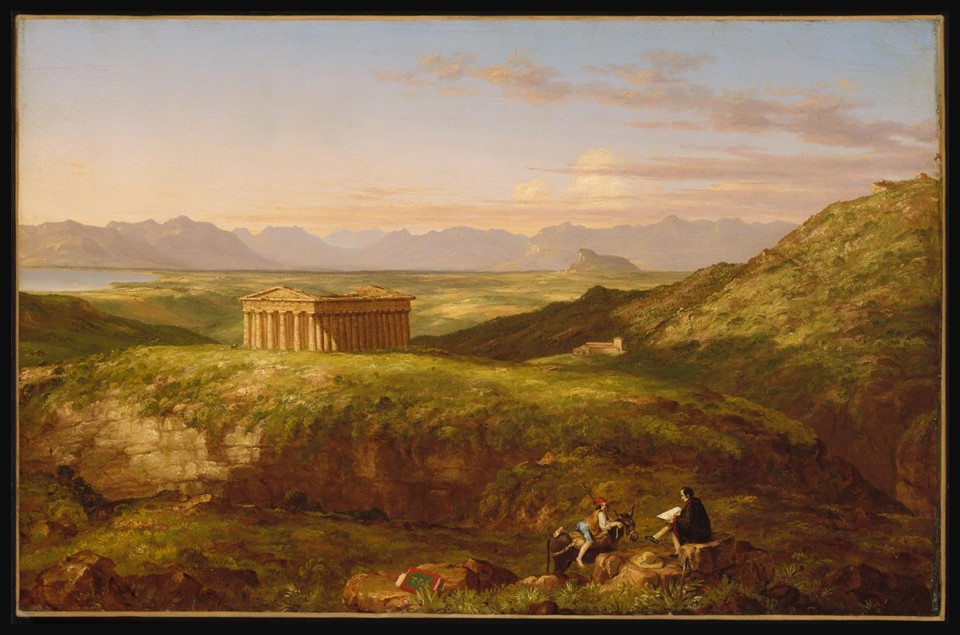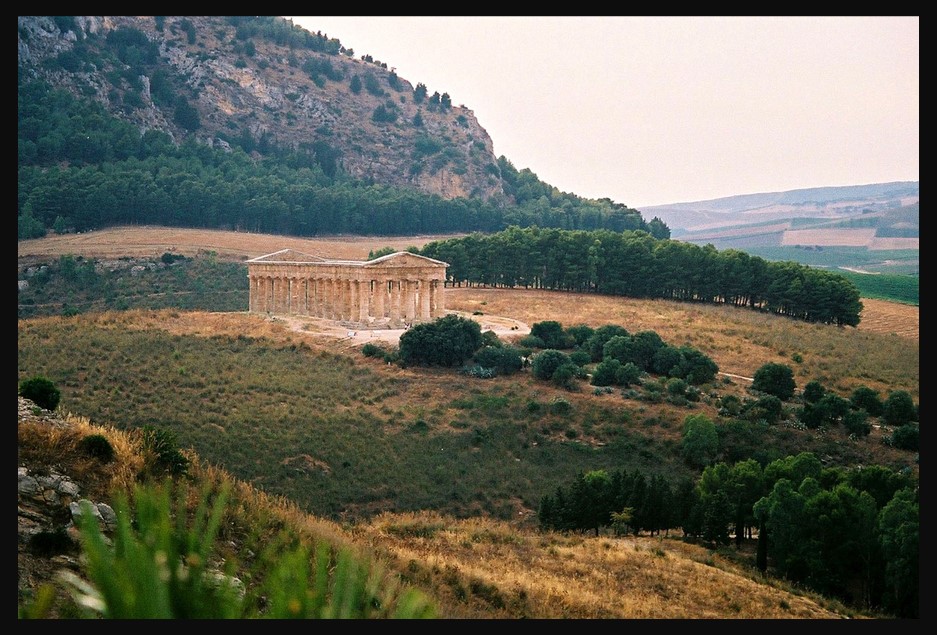
The Temple of Segesta with the Artist Sketching, circa 1842, oil on canvas, 49.8×76.5 cm, Museum of Fine Arts, Boston, USA https://en.m.wikipedia.org/wiki/File:Cole_Thomas_The_Temple_of_Segesta_with_the_Artist_Sketching_1843.jpg
O that I was there again, and in the same spirit! wrote Thomas Cole in 1834, in the letter he sent to William Dunlap, for publication in the latter’s book, the ‘History of the Rise and Progress of the Arts of Design in the United States’. The artist was fortunate to revisit Italy in 1841/42, from November 1841 through May 1842. These seven months in Italy marked one of the artist’s most productive periods, during which dozens of canvases were created, most of them showcasing the architectural glory of Italy’s antiquity. My new BLOG POST, The Temple of Segesta by Thomas Cole, features one of these paintings, presenting an intriguing example of a combined landscape and self-portrait scene! https://www.kemperartmuseum.wustl.edu/node/11262
The Temple of Segesta stands as an iconic testament to ancient Greek architecture, nestled amidst the picturesque landscapes of northwestern Sicily, in Italy. Believed to have been constructed around the 5th century BC by the Elymians, an indigenous Sicilian people, the Temple is a magnificent Doric structure that has endured centuries, maintaining its grandeur and allure. The temple’s majestic columns, characterized by their timeless simplicity, rise proudly against the backdrop of rolling hills, creating a scene of remarkable historical resonance. Surrounded by an aura of mystery, the Temple of Segesta invites visitors to embark on a journey through the remnants of classical antiquity, offering a glimpse into the rich cultural tapestry of the region. Its enduring presence and architectural splendor make the Temple of Segesta a captivating destination for history enthusiasts and admirers, like Thomas Cole, of ancient civilizations alike.

The Temple of Segesta by Thomas Cole, housed in the Metropolitan Museum of Art in New York City, is a captivating artistic rendition that brings the ancient structure to life on canvas. Executed during the artist’s visit to Italy in 1841/42, the painting reflects Cole’s mastery in capturing the essence of historical and architectural marvels. The Temple of Segesta, with its majestic silhouette, becomes a focal point within the artwork, surrounded by the lush landscapes that often characterize Cole’s romanticized depictions. The meticulous attention to detail and the play of light and shadow in the painting evoke a sense of timelessness, transporting viewers to the ancient realm of Segesta.
A fascinating element unfolds as the artist ingeniously incorporates a self-portrait within the scene. The composition subtly reveals Cole in the act of sketching, positioned within the broader landscape of the ancient temple. Through skillful brushstrokes and nuanced details, Cole captures himself engaged in the artistic process, seamlessly blending the realms of creation and observation. The inclusion of the self-portrait adds a layer of narrative depth, inviting viewers to contemplate the intersection of the artist’s presence with the historical and architectural subject matter. This deliberate inclusion not only showcases Cole’s technical prowess but also provides a unique perspective into the artist’s connection with the Temple of Segesta, creating a dynamic interplay between the observer, the artist, and the timeless beauty of the depicted scene.
As a part of the Metropolitan Museum’s collection, this painting not only preserves the beauty of the Temple of Segesta but also serves as a testament to Thomas Cole’s enduring legacy of capturing the spirit of both nature and history through his art.
Thomas Cole, born on February 1, 1801, in Bolton-le-Moors, Lancashire, England, emerged as a prominent figure in 19th-century American art, particularly as the founder of the Hudson River School. Emigrating to the United States with his family in 1818, Cole’s early artistic endeavors unfolded in Philadelphia before he gained recognition for his landscape paintings that depicted the American wilderness in its sublime beauty. His career took a significant turn when he traveled to Europe in the 1820s, absorbing the influences of European art and cultivating a deep appreciation for classical and historical subjects. Returning to the U.S., Cole’s panoramic landscapes, marked by meticulous detail and romanticism, established him as a leading artist of his time. Notable works like “The Course of Empire” series and his depictions of the Catskill Mountains solidified his reputation. Thomas Cole’s untimely death in 1848 marked the conclusion of a prolific career that left an indelible mark on American landscape painting, inspiring generations of artists to come.
For a Student Activity inspired by Thomas Cole’s landscape paintings, please… Check HERE!
Interesting to read: History of the Rise and Progress of the Arts of Design in the United States, by William Dunlop, in 2 Volumes, George P. Scott and Company, Printers, 1834 https://books.google.gr/books?id=tJNAAAAAYAAJ&pg=PA364&lpg=PA364&dq=%E2%80%9CO+that+I+was+there+again,+and+in+the+same+spirit!%E2%80%9D&source=bl&ots=F_JtbUxzrG&sig=ACfU3U0zijol2CsenuZbywUHWpAkvYNP0w&hl=el&sa=X&ved=2ahUKEwi6xKiZyfeCAxXoR_EDHejjAKgQ6AF6BAgJEAM#v=onepage&q=%E2%80%9CO%20that%20I%20was%20there%20again%2C%20and%20in%20the%20same%20spirit!%E2%80%9D&f=false